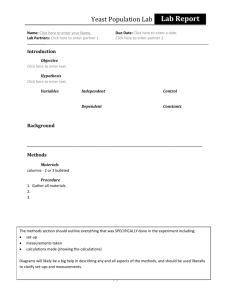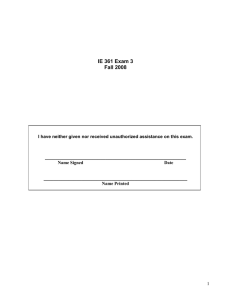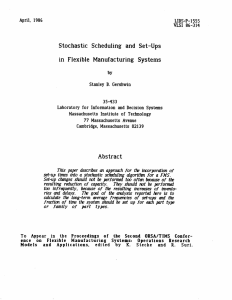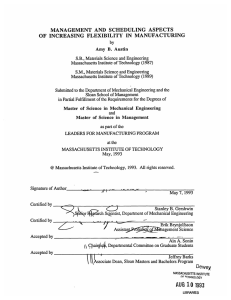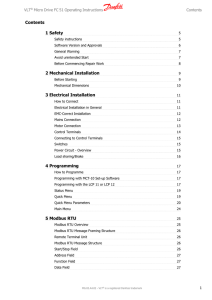An IE 361 project group worked with a plastics manufacturer... process. They conducted what was ultimately a (partially... IE 361 Exam 3
advertisement
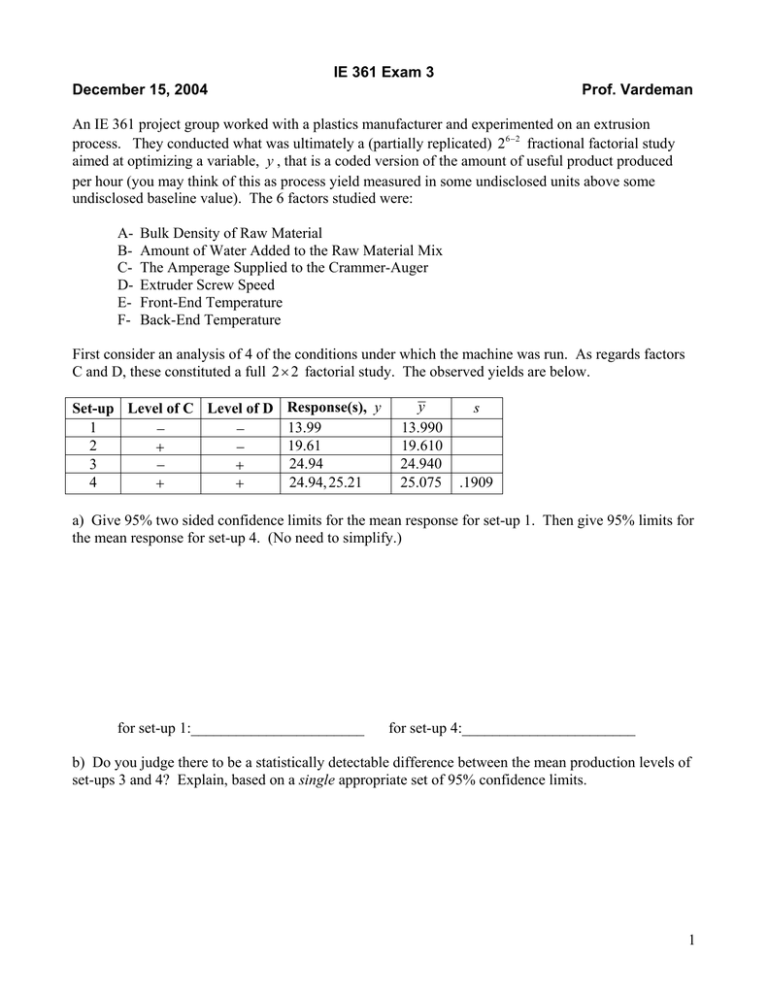
IE 361 Exam 3 December 15, 2004 Prof. Vardeman An IE 361 project group worked with a plastics manufacturer and experimented on an extrusion process. They conducted what was ultimately a (partially replicated) 26 − 2 fractional factorial study aimed at optimizing a variable, y , that is a coded version of the amount of useful product produced per hour (you may think of this as process yield measured in some undisclosed units above some undisclosed baseline value). The 6 factors studied were: ABCDEF- Bulk Density of Raw Material Amount of Water Added to the Raw Material Mix The Amperage Supplied to the Crammer-Auger Extruder Screw Speed Front-End Temperature Back-End Temperature First consider an analysis of 4 of the conditions under which the machine was run. As regards factors C and D, these constituted a full 2 × 2 factorial study. The observed yields are below. Set-up Level of C Level of D Response(s), y 13.99 1 − − 19.61 2 + − 24.94 3 − + 4 24.94, 25.21 + + y 13.990 19.610 24.940 25.075 s .1909 a) Give 95% two sided confidence limits for the mean response for set-up 1. Then give 95% limits for the mean response for set-up 4. (No need to simplify.) for set-up 1:_______________________ for set-up 4:_______________________ b) Do you judge there to be a statistically detectable difference between the mean production levels of set-ups 3 and 4? Explain, based on a single appropriate set of 95% confidence limits. 1 c) Treat the 4 set-ups listed in the table on page 1 as a 22 factorial in factors C and D. Find fitted main effects of C and D ( c2 and d 2 ) and the fitted CD interaction ( cd 22 ) if one takes this point of view. d) Which (if any) of the fitted/estimated effects you computed in part c) are "statistically significant"? (Base your answer on appropriate 95% confidence limits and explain.) e) As a matter of fact, while levels of factors A,B, and E were held constant across set-ups 1 through 4 in listed in the table on page 1, set-ups 1 and 3 were made with the high ( + ) level of factor F and setups 2 and 4 were made with the low level ( − ) of factor F. Even limiting attention to the single set of levels of A,B and E represented in set-ups 1 through 4, this last fact (about factor F) should probably change your interpretation of the results of parts c) and d). Explain. We will henceforth consider the whole 26 − 2 experiment run by the students. As a matter of fact, they used the two generators E ↔ AB and F ↔ AC f) What levels of E and F were used with the following combinations of A,B,C and D? (Fill in the blanks.) Level of A + + + Level of B + + − Level of C + − − Level of D − − − Level of E Level of F 2 The students reported a "4 degree of freedom" pooled sample standard deviation of .37. Further, the sum of the reciprocals of their 16 sample sizes was 14. g) A "fitted sum of effects" computed via the Yates algorithm based on the 16 sample means can be used to make 95% confidence limits of the form n fitted sum of effects ± ∆ for an appropriate value ∆ . Find this value. Below is a table of 16 ABCDEF combinations with corresponding sample means, and a final column that comes from use of the Yates algorithm on the sample means. Combination ef a bf abe ce acf bc abcef def ad bdf abde cde acdf bcd abcdef y 13.99 6.76 20.71 11.12 19.61 15.73 23.45 20.00 24.94 24.53 24.97 24.29 25.08 24.40 30.00 33.08 Output of the Yates Algorithm 21.42 -1.43 2.04 .10 2.50 .81 .68 .43 4.99 1.59 -.36 .34 -.77 -.37 1.05 .08 h) How many "cycles" of additions and subtractions and what final divisor were used to produce the last column in the above table? number of cycles ____________________ final divisor ______________________ i) Circle values in the last column of the table that represent "statistically detectable sums" according to the criterion of part g). 3 As it turns out, the pooled sample standard deviation reported by the students is probably "too small" because their "replication" consisted of consecutive runs of the machine for a given set-up. Experience with the machine strongly suggested that for a given combination of levels of the factors A through F, consecutive runs for a given set-up were more homogeneous than were runs where the same combination of levels of A through F was used, but other (different) set-ups intervened between the runs. So the practical implications of part i) are suspect, and a second way of judging the statistical detectability of sums of effects was tried. A normal plot of the last 15 entries in the "Output of the Yates Algorithm" column in the table on the previous page was made. It is below. j) On the basis of the plot above, what value(s) in the table on page 3 clearly represent statistically detectable sum(s) of effects? Explain. k) What is the simplest possible interpretation of your answer to j)? If the object of running the machine is "large y " what does j) suggest about how the machine should be set up (which levels of which factors should be used)? l) Say why, in retrospect, your answer to k) is clearly consistent with the list of sample means in the table on page 3. 4



